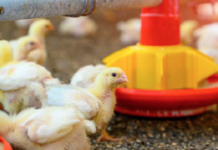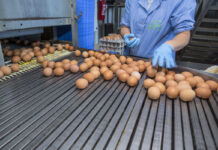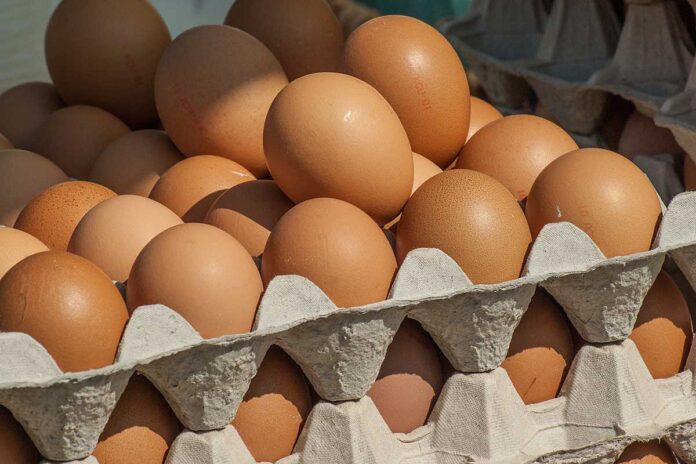
Food supply for a growing global population is one of the great challenges for the next decades. A particular problem will be to produce sufficient proteins, especially of animal origin. Meat and eggs are beside milk the most valuable sources for human nutrition. In this paper, a projection of the development of egg production between 2020 and 2030 will be presented.
Hans-Wilhelm Windhorst
The author is Prof. emeritus at the University of Vechta and Visiting Professor at the Hannover Veterinary University
The challenge of feeding a growing global population
The development of the global population and the changing social and economic conditions will have decisive impacts on the demand for food. The expected increase in the per capita consumption of animal products by a broadening middle-call in threshold and developing countries will result in a growing demand. The question is, if and how this demand can be produced.
Between 1960 and 2020, the global population increased from 3.0 to 7.8 billion or by 157%. Between 2020 and 2050, another growth by 2 billion is expected (Figure 1). 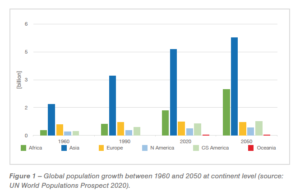 To this increase, Africa will contribute 1.1 billion, Asia 650 million and Central and South America 110 million. Most of the threshold and developing countries are located in these three continents, which impressively illustrates the challenge of future food security. African and Asian countries together will share 86.4% in the global population increase between 1960 and 2050 (Figure 2) and even 87.5% in the coming three decades.
To this increase, Africa will contribute 1.1 billion, Asia 650 million and Central and South America 110 million. Most of the threshold and developing countries are located in these three continents, which impressively illustrates the challenge of future food security. African and Asian countries together will share 86.4% in the global population increase between 1960 and 2050 (Figure 2) and even 87.5% in the coming three decades. 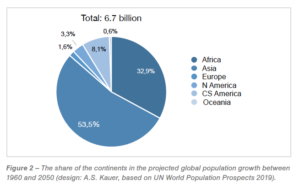 If it will not be possible to produce sufficient food, famines and a migration of people from regions with an insufficient food-supply to regions with an oversupply may be the consequence. Eggs will play an important role in food security not only because of their exceptional nutritional value, but also because of the lack of religious barriers regarding consumption and comparatively low production cost resulting from the favourable feed-conversion rate of laying hens.
If it will not be possible to produce sufficient food, famines and a migration of people from regions with an insufficient food-supply to regions with an oversupply may be the consequence. Eggs will play an important role in food security not only because of their exceptional nutritional value, but also because of the lack of religious barriers regarding consumption and comparatively low production cost resulting from the favourable feed-conversion rate of laying hens.
Considerable differences in the production dynamics at continent level
Between 1960 and 2020, global egg production increased from 33.6 to 87.6 mill. t or by 160.7%. Only poultry meat production grew faster. It is expected that the dynamical development will continue over the next decade. Table 1 shows that 76.6% of the projected growth in egg production will occur in developing countries, documenting the important role which they will play in food security in the developing world. In the next decade almost 4.3 mill. t more eggs will be produced in developing countries than in developed countries.
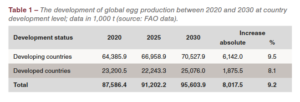
A more detailed analysis at continent level reveals considerable differences in the absolute and relative growth rates (Figure 2, Table 2).
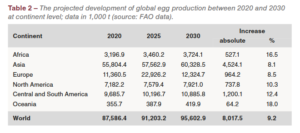 Of the 95.6 mill. t of eggs which are projected for 2030, 60.3 mill. t or 63.1% will be contributed by Asian countries, followed by European countries with 12.3 mill. t or 12.9%. In the absolute growth of 8.0 mill. t, Asia will share 4.5 mill. t respectively 56.4%. The absolute increase in Central and South America is predicted with 1.2 mill. t, in Europe with 964,200 t. A closer look at the relative growth rates presents a different picture. Here, Oceania is in a top position with 18.0%, almost double the global average, followed by Africa with 16.5% and Central and South America with 12.4%. For North America, a relative increase by only 10.3% is projected.
Of the 95.6 mill. t of eggs which are projected for 2030, 60.3 mill. t or 63.1% will be contributed by Asian countries, followed by European countries with 12.3 mill. t or 12.9%. In the absolute growth of 8.0 mill. t, Asia will share 4.5 mill. t respectively 56.4%. The absolute increase in Central and South America is predicted with 1.2 mill. t, in Europe with 964,200 t. A closer look at the relative growth rates presents a different picture. Here, Oceania is in a top position with 18.0%, almost double the global average, followed by Africa with 16.5% and Central and South America with 12.4%. For North America, a relative increase by only 10.3% is projected.
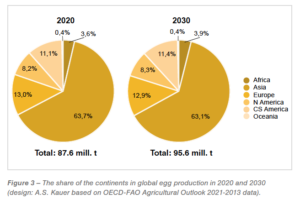
Figure 3 documents the changing contribution of the continents to the global production volume between 2020 and 2030. Asia and Europe will lose shares, Africa as well as Central and South America will gain shares.
Asian countries will dominate egg production dynamics
The future development of egg production will not only depend on the increase of the population but also on the dynamics in the per capita consumption. The OECD-FAO outlook projects only a minor growth of the global per capita consumption from 10.50 kg to 10.53 kg in the analysed decade. Table 3 documents the projected changes for selected countries with a low respectively high per capita consumption.
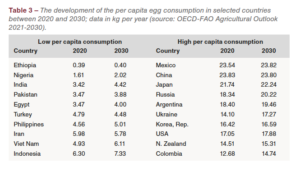
A comparison of the composition and ranking reveals some interesting insights. The wide gap between Ethiopia with a per capita consumption of only 0.40 kg and Mexico with 23.82 kg not only reflects the development status of the countries, but also the availability of eggs and their role in the human nutrition. In several countries, consumption will decrease because of a stable production and a fast population growth (Turkey, Iran); in others, consumption will increase considerably despite a growing population (Colombia, Viet Nam, India). In Japan, egg production will decline despite a growing per capita consumption because of the decreasing population. In China, the per capita consumption will remain stable on a high level; the increasing egg production reflects the population dynamics.
Table 4 presents the projected development of egg production between 2020 and 2030 in the ten countries with the highest production volume.
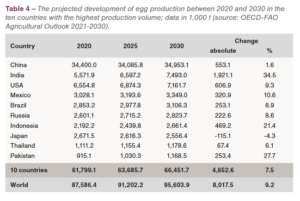
A detailed analysis of the ranking of the countries and the expected dynamics between 2020 and 2030 reveals some interesting changes (Figure 4). India is expected to replace the USA in second rank and to increase its production volume by almost 2 mill. t. Japan will be the only country with a production decrease. The highest relative growth rates are projected for India, Pakistan and Indonesia. In 2030, the ten leading countries will share 69.5% in global egg production, 1.1% less than in 2020. To the total increase of the global production volume, the six Asian countries, as listed in Table 4, will contribute 40.7%.
The projected dynamics will have impacts on the share of the single countries in global egg production volume (Figure 4). China will lose 2.7% of it share in 2020 while India will gain 1.4%. The contribution of the six Asian countries will decrease from 53.6% to 52.3%. Nevertheless, they will still be dominating global egg production in 2030.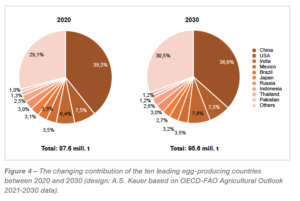
Summary and perspectives
The preceding analysis showed that food security is one decisive challenge for the next decades. Eggs will play an important role in future food supply because of their high nutritional value. They are an important protein source not only for developed countries, but in particular for developing countries because of the excellent feed conversion rate of laying hens, which results in lower production costs in comparison to red meat. In their Agricultural Outlook, OECD-FAO predict an increase of the global egg production by 8.0 mill. t between 2020 and 2030. To this growth, Asian countries will contribute 4.5 mill. t or 56.4% They will also in future dominate egg production dynamics. The highest absolute growth is projected for India with 1.9 mill. t, followed by the USA and China. Of the leading egg producing countries, only Japan will face a decrease in the production volume. The situation of food security will still be critical in the next decade in Africa, as only 6.6% in the global egg production will be shared by this continent.
Data sources and suggestions for further reading
- OECD-FAO Agricultural Outlook 2021-2030. https://stats.oecd.org.
- UN World Population Prospects 2019. https://population.un.org.
- Windhorst, H.-W.: Dynamics and patterns of the egg industry in the Emerging Market Countries between 2007 and 2017. Part 1: The dynamics of the laying hen inventories. In: Zootecnica International 42 (2020), no. 3, p. 26-30.
- Windhorst, H.-W.: Dynamics and patterns of the egg industry in the Emerging Market Countries between 2007 and 2017. Part 2: The development of egg production. In: Zootecnica International 42 (2020), no. 4, p. 28-32.
- Windhorst, H.-W.: The forgotten continent. Patterns and dynamics of the African egg industry. Part 1: Laying hen inventory and egg production. In: Zootecnica International 42 (2020), no., p. 24-27.
- Windhorst, H.-W.: The forgotten continent. Patterns and dynamics of the African egg industry. Part 2: The egg industry in the sub-regions. In: Zootecnica International 42 (2020), no. 10, p. 22-28.
- Windhorst, H.-W.: The Champions League of the egg producing countries. In: Zootecnica International 43 (2021), no. 1, p. 26-29.
- Windhorst, H.-W.: The forgotten world: the egg industry in the least developed countries. In: Zootecnica International 43 (2021), no. 2, p. 22-25.



